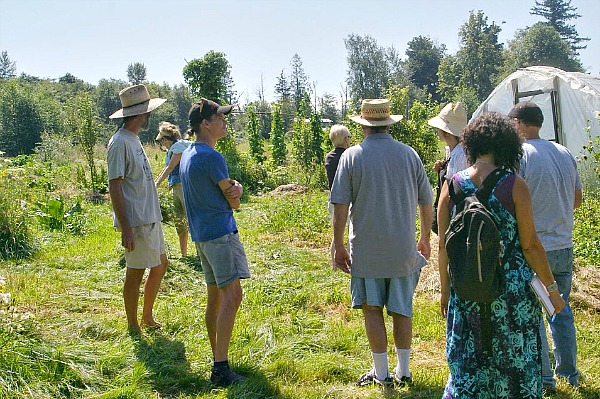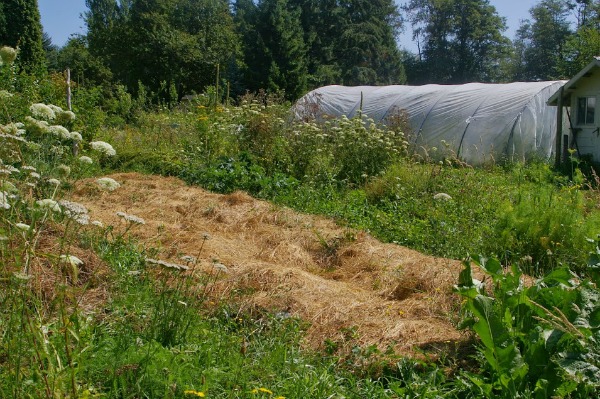Permaculture farm tour with Larry Korn in the Pacific Northwest
© National Lilac Publishing, LLC
Larry Korn came to Inspiration Farm in northwest Washington State. We participants got to see many permaculture methods in practice, as well as just plain clever ideas that make their holistic, regenerative nine acres operate so well.
A broad fork is used to build loose, raised planting beds.
Dry organic matter suppressing weeds and decomposing for a future planting bed
Portable chicken coop.

An old trampoline serves as portable shade for the chickens, and also a place for them to duck under if a predator bird is spotted. Notice also the portable fencing keeping them where they need to be, and out of garden beds. Persistent flying predators will at times land on the ground and pursue their prey from there, as could happen here. But some can be discouraged from bothering if hens move beneath the big strange looking object. Do be mindful of high winds, perhaps staking it down. After a large windstorm in my area, I found someone else's trampoline in my field!
This is a portable high protein chicken feeder that works very well in warmer weather. Meat scraps or sometimes roadkill and other accidentally killed animals otherwise not used for food or feed are placed in the bottom of the bucket. Dry plant matter such as straw is put on top to absorb odor. Sometimes the meat and dry matter are layered. Flies enter to lay eggs in the meat scraps.
The resulting maggots crawl out of the holes and drop to the ground below and are relished by the chickens (who also sometimes catch the flies). Chickens then turn flies and maggots into delicious eggs. When the buckets are emptied, only bones and straw are left.
Another angle of the portable chicken enclosure.
Notice how there is virtually no bare ground on this farm, either plants are growing or mulch is atop unplanted areas.
Vertical growing takes place in various locations on the farm.
The hoop house in the distance, garden crops and various useful plants growing in the foreground.
Tomatoes growing in the hoop house. This adds warmth for heat loving tomatoes grown here where summers can be cool. Tomatoes are self fertile and either a breeze or gently shaking the plants by hand will pollinate them.
Enjoying sitting in some shade while Larry shares more fascinating permaculture knowledge. Notice the rain barrel next to the building behind Larry.
Newly dug crops drying in the sun.
Drying crops further along on their drying journey.
With unpredictable weather, crops that need to be dried in the late summer and fall do well with an indoor option for drying.
Nasturtiums, which are edible, grow along with other pollinator plants in various locations throughout the farm.
Their honor system farmstand.





















